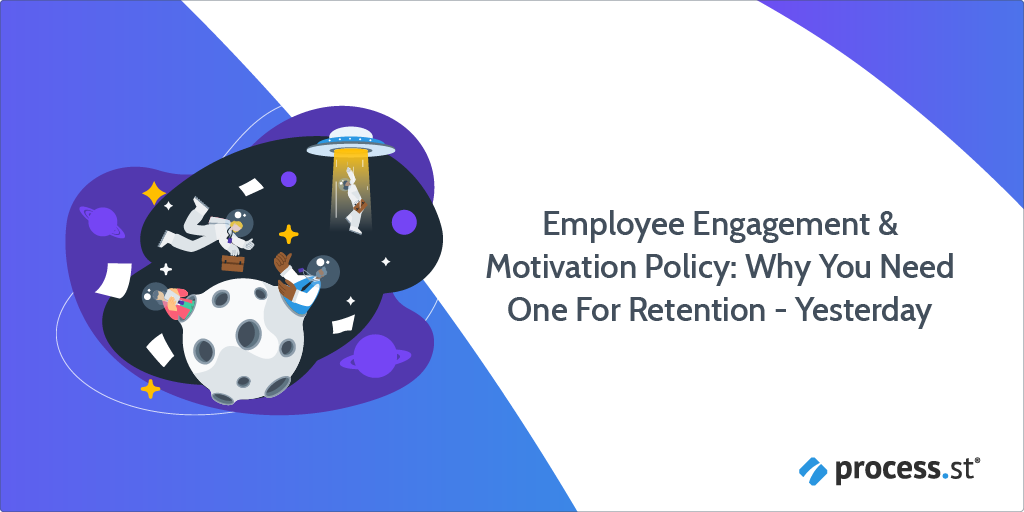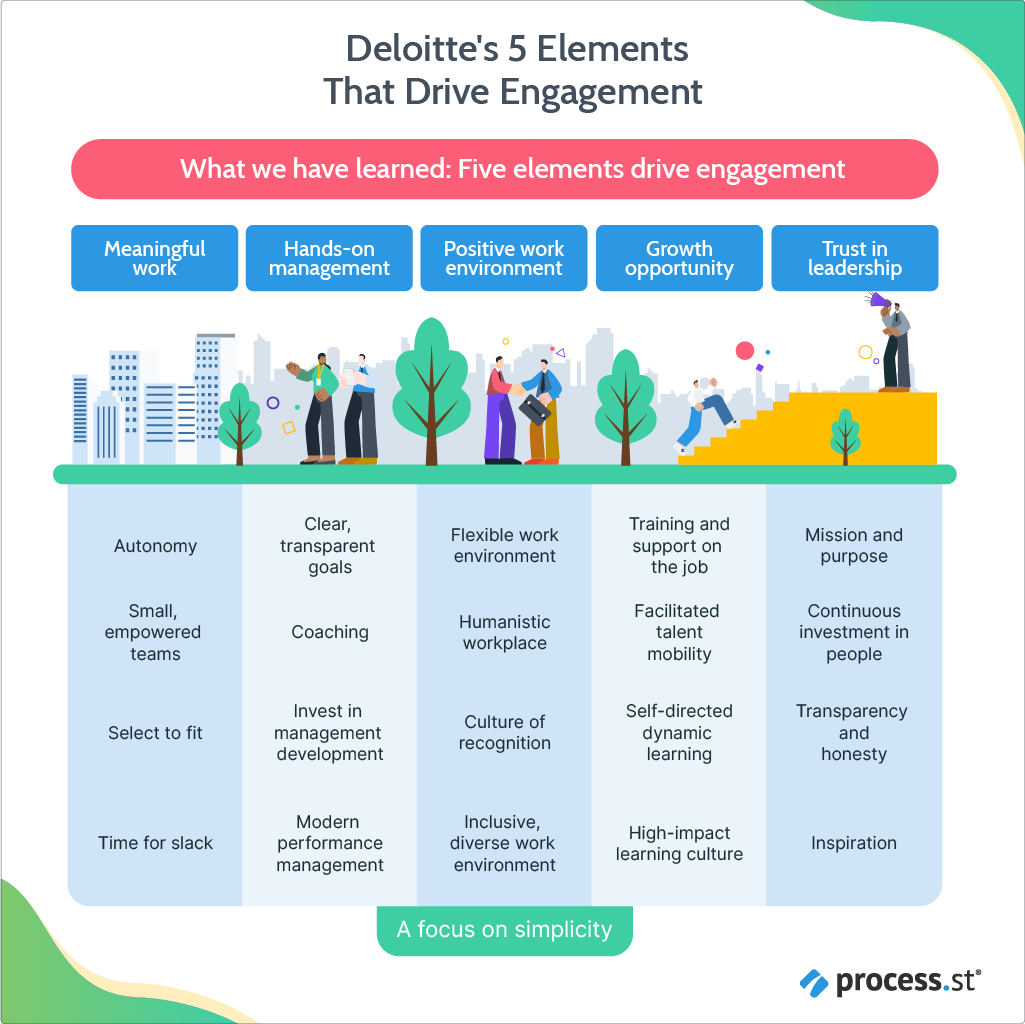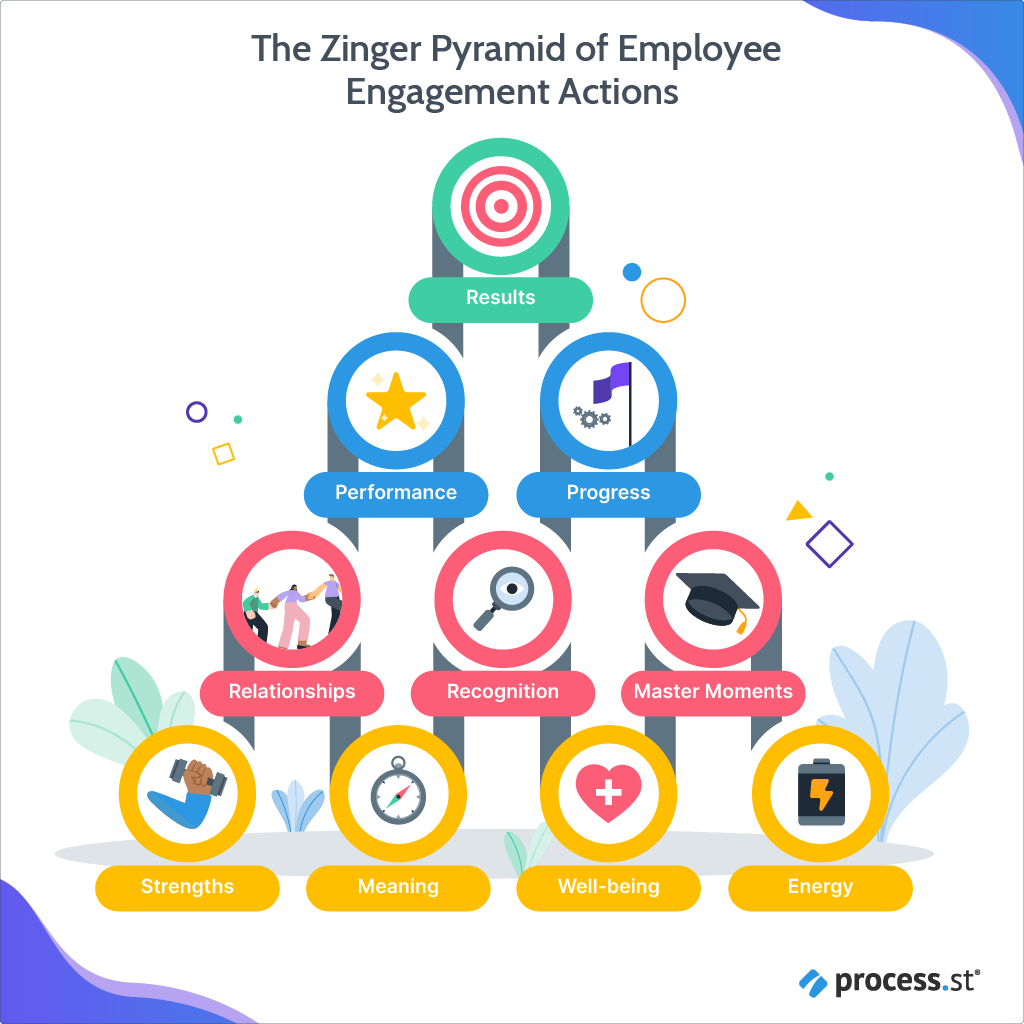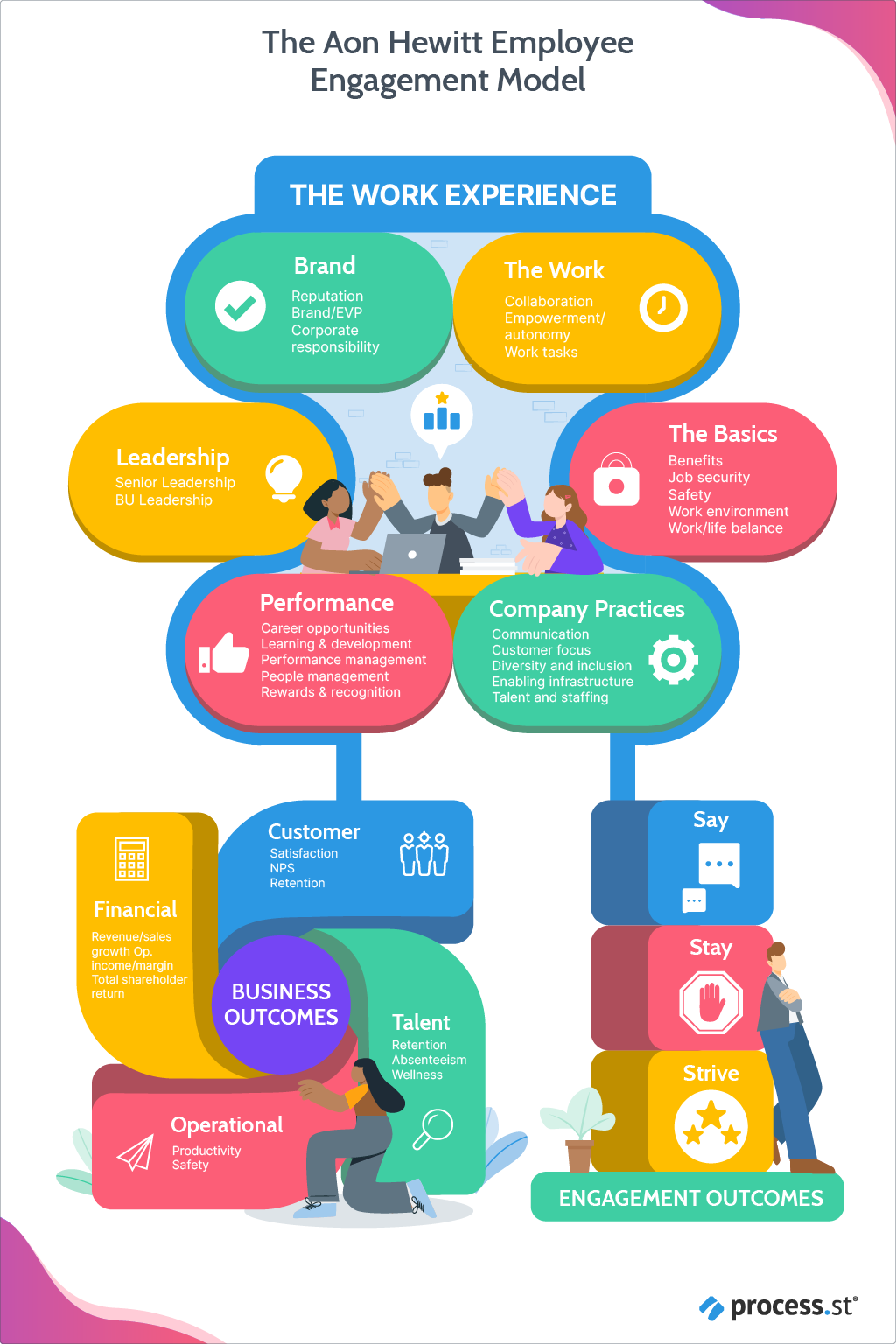
Without a well-structured policy, lack of engagement and motivation can slowly eat away and undermine your company and your workforce unnoticed until it’s too late.
So, let’s talk about why engagement and motivation are so important and how to implement good policies without utterly alienating your workforce. Here at Process Street, that’s just the sort of thing we do best.
Check it out:
- Are employee engagement & motivation the same thing?
- Deloitte’s 5 Elements That Drive Engagement
- The Zinger Pyramid of Employee Engagement Actions
- The Aon Hewitt Employee Engagement Model
- Using modern process management to build effective policies
Let’s dive in!
Are employee engagement & motivation the same thing?
No, they are not.
According to Professor William A. Kahn, Ph.D. (Boston University), employee engagement is:
“The ‘harnessing of organizational members’ selves to their work roles; in engagement, people employ and express themselves physically, cognitively and emotionally during role performances.”
– “Psychological conditions of personal engagement and disengagement at work.” Academy of Management Journal, 33: 692-724. [1990]
In other words, engagement is about how closely the company’s and the employee’s objectives are aligned. Engagement can be affected by a number of things:
- Involvement in particular social issues;
- Work environment and conditions;
- Attitude of management and leadership towards employees as individuals or as a whole;
- Positive culture with a general feeling of care towards their wellbeing.
That list is by no means exhaustive, but it’s a rough idea of what drives engagement. Employee engagement, essentially, is exactly what it sounds like: How interested are your employees in your company’s success?
Income and job security are obvious motivators, but don’t make it into most employees’ top 5:
- Transparent communication
- Challenges at work
- Recognition for accomplishments
- Cohesive teams
- Autonomy
The following three models work because they aren’t static models. Each one of them includes plenty of room for flexibility, improvisation, and innovation. If you thought you were going to get off the hook with a one-size-fits-all engagement model, you are sorely mistaken. You need to know what drives your employees, or these models are worthless.
Deloitte’s 5 Elements That Drive Engagement

If you take a look at the diagram above, you’ll see a lot of these major elements are things I’ve already mentioned, but for the sake of over-communicating (twice!), let’s run through them point by point:
1. Meaningful work: A sense of meaningful work starts well before the employee has even been hired. You need to find the right person to fit the job and sometimes that person that fits best isn’t the most obvious. So first thing: Job-person fit.
2. Hands-on management: A hands-on manager is involved in what their team is doing, but not dictating how it’s done. It’s the middle ground between being inaccessible in your office and hovering over every keystroke made.
3. Positive work environment: Make sure your employees want to be there. If they don’t feel like they’re being heard or valued, they aren’t going to be engaged with their work.
4. Growth opportunity: 93% of employees say they feel more engaged at work if there’s a well-planned training opportunity. Employees – like most people – want to grow and challenge themselves. If you don’t offer those opportunities, they’ll very quickly find somewhere that will.
5. Trust in leadership: You have to give your employees a reason to trust you, and it can’t just be your job title. They may follow you, they may do what you tell them, and they may display the behaviors you want them to display, but to truly get them to trust you there has to be transparency, communication, and value. If your employees know you’ll stand behind them, they’ll be willing to give you their trust.
The Zinger Pyramid of Employee Engagement Actions

Zinger’s pyramid is comprised of 10 blocks that form a pyramid. These blocks are meant to be flexible and moved around as needed. Your team may be motivated and engaged around one goal by recognition, but for another, it might be meaning or relationships that need to be tapped into.
The 10 blocks are:
- Results
- Performance
- Progress
- Relationships
- Recognition
- Moments
- Strengths
- Meaning
- Wellbeing
- Energy
The essence of why this pyramid works, according to creator David Zinger, is not to be a simple structure you follow:
“I like the 10 bricks and the pyramid but you can use your own bricks or another structure for employee engagement. Perhaps you can use my bricks or structure as a foundation or a launching pad. Or maybe in rejecting my bricks and structure you make a stronger declaration of your own approach. They key is that it has to work for you and who you work with.”
– David Zinger, “Employee Engagement: Give me an inch”
The Zinger Pyramid of Engagement gives you the tools to build what you need when you need it.
The Aon Hewitt Employee Engagement Model

The Aon Hewitt model is slightly different in that it’s not a model to follow in order to increase engagement, but a model you can use to determine how engaged your employees actually are.
At the top of the diagram, there are the 6 engagement drivers:
- Brand
- Leadership
- Performance
- Company Practices
- The Basics
- The Work
These 6 things all feed into the employee’s satisfaction and engagement with the company. To determine how well these drivers are working, the Aon Hewitt model relies on the very catchy “Say, Stay, Strive” definition of engagement.
If an employee is actively engaged at work, an example of behaviors they’d demonstrate would be:
- Say: The employee would speak positively about the company to others.
- Stay: They would have a sense of belonging at the company.
- Strive: The employee is motivated to exert extra effort for their job and the company.
If all three of these conditions are met, the employee is deemed to be fully engaged.
The final section of the model involves the business outcomes as a result of engaged employees:
- Talent retention and lower absenteeism;
- Improved productivity and safety;
- Higher customer satisfaction and retention;
- Increased sales growth and total shareholder return.
In short, if you’re employees are happy, you make more money.
Using modern process management to build effective policies
Process Street workflows, Automations, and Pages are powerful tools to make your engagement initiatives so simple you don’t have to think about them.
Automations
Process Street Automations feature allows you to connect your Process Street workflows to your other work apps like Google Sheets, DocuSign, Slack, and many others.
Let’s say you want to post a greeting in the company Slack channel every time there’s a new hire; Automations can do that for you.
It’ll also reduce your employees’ tedious jobs like data entry, which will definitely make them happier with you. With Automations, you can send data both to and from other apps – automatically.
Let’s say you close a sale in Salesforce so need to initiate the customer onboarding process. You can set a trigger so that as soon as that sale is saved as closed, the customer onboarding workflow automatically starts without your employee – or you – having to do a thing.
Check out this webinar to see all the cool stuff Automations can do:
Pages
Pages is essentially that binder stuffed in an old filing cabinet that nobody uses – except your employees will use it.
Pages is the free for everyone digital knowledge base you’ve always dreamed of. Plus, it lives side-by-side with your dynamic workflows (and can even have workflows embedded in Pages) to create a truly centralized hub.
With Pages, your employees will always know where to find the crucial info they need and – again – save valuable time by having it all right at their fingertips.
It’s also a great feature to store all your company policies and procedures from employee handbooks to vacation requests. That sort of transparency and ease of use is exactly the sort of thing that keeps employees engaged.
This video will give you an introduction to Pages:
Workflows
Workflows are the foundation of it all. A workflow is essentially a template of a process you use regularly. Anytime you need to use that process, you run the workflow template and every step of the process is laid out, in order, every time.
No more long, confusing instructions that may or may not have missing pages. No more needing that one specific employee every time the process needs to run. Within a few seconds, anyone can run a workflow and complete it – error-free.
Check out more on workflows and process automation in this video:
What strategies do you use to keep your employees engaged? Let’s talk about it in the comments!







 Workflows
Workflows Projects
Projects Data Sets
Data Sets Forms
Forms Pages
Pages Automations
Automations Analytics
Analytics Apps
Apps Integrations
Integrations
 Property management
Property management
 Human resources
Human resources
 Customer management
Customer management
 Information technology
Information technology



Leks Drakos
Leks Drakos, Ph.D. is a rogue academic with a PhD from the University of Kent (Paris and Canterbury). Research interests include HR, DEIA, contemporary culture, post-apocalyptica, and monster studies. Twitter: @leksikality [he/him]